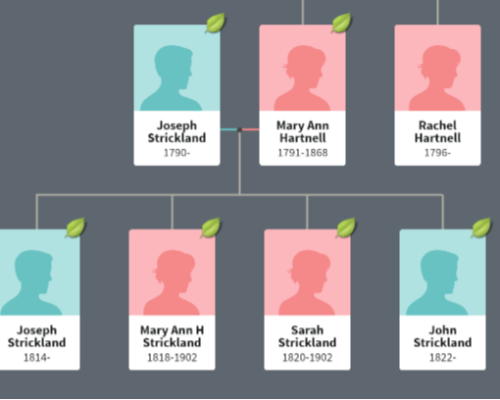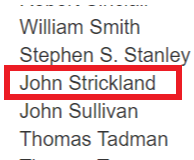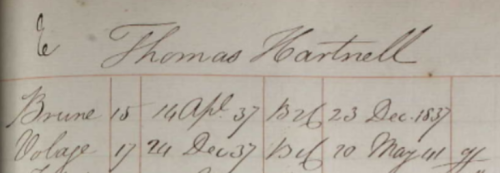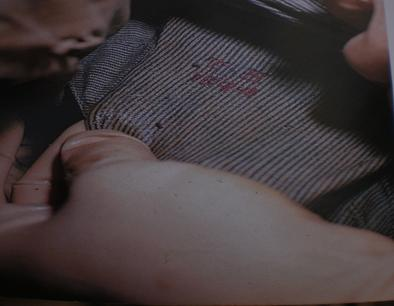Finding Mr. Strickland
It's been a good minute or two since I last updated this blog, and I figured the best way to do so was to pick up precisely where I left off with Hartnell research. My last post about the Hartnell family is definitely in sore need of updating (I've learned way more since then!), but I've been so excited about the topic I'm outlining today that it can wait another... year or so. I kid. Hopefully.





Since late 2016, researching the Hartnell family has been a sort of core focus of mine. As far as a return on my efforts go, it hasn't been much as - first of all - I live very far away from the National Archives, SPRI, Chatham Dockyard, Gillingham, &c. since there are quite a few miles between Michigan and England and I'm not exactly celebrating any major financial bounty that'll get me there any time soon. Secondly, John and Thomas Hartnell's family were not wealthy or had any major social bearing outside of an uncle who was a respected clerk in Plymouth, so the emphasis on keeping detailed records just wasn't there. In fact, it was only after the brothers disappeared that the family seemed to find much relevance in keeping any records at all. That being said, since I made the post about John Hartnell in 2017, I have made progress. It hasn't just been me sitting in the gloom of my bedroom with a coffee cup full of Frangelico every night!
One of the most potentially important finds I've managed to unearth is the possibility of there being a third Hartnell family member on the Franklin Expedition. Now, I say possibility since "watertight theories" and "Franklin Expedition" are sort of oxymorons, and I can be proven wrong as easily as I can be proven right. This thus established, I'd like to posit the theory that John Strickland, able-bodied seaman aboard the HMS Erebus was the first cousin of John and Thomas Hartnell.
To establish this theory, I have to give some further background to the Hartnell family that I've discovered since I started my research (if this bores you, please scuttle on down the page until you see pretty colors, and I'll pick up from there).
Thomas Hartnell (c. 1789-1832) was born in Stoke Damerel, Devon, in what is now modern-day Plymouth. He was one of six children born to John and Martha Hartnell and grew up in a family of shipwrights and sailors. Most of the Devon Hartnells stayed in Stoke Damerel and the surrounding areas, and while Thomas was apprenticed at the local dockyard (according to the Hartnell Papers at SPRI), he would go on to take a job at Chatham Dockyard in Kent, leading him to eventually meet and marry Sarah Friar of Teynham, Kent and have six children with her, one of whom died in infancy. His eldest sons, John and Thomas, don't really need to be introduced.
Thomas' younger sister, Mary Ann Hartnell, known sometimes just as "Ann" (and not to be confused with Thomas' daughter, Mary Ann Hartnell - the Hartnell family were expert name-recyclers) was born around 1791 in Stoke Damerel and, at some point, lived in Barnstaple as well as Portsmouth. She married one Joseph Strickland and would have four children with him: Joseph, Mary Ann (again with the name recycling), Sarah, and John.

(Yes, I'm using Ancestry. No, I will not be judged. Yes, I have more sources than just this. Give me a second.)
(And double note that the "H" in the younger Mary Ann's name is for "Hartnell", which she used with a hyphenation.)
Now, to people like me who sometimes just look at the Franklin Expedition muster records for funsies, John Strickland's name might look a bit familiar, if only because it's been seen with other familiar names, as so:

(And fun fact: John Sullivan and Thomas Tadman were also from the Brompton-Gillingham area of Kent, as were the Hartnell brothers. Nifty!)
If we're considering the Hartnell-Strickland family connection here, it makes sense that this John Strickland would choose a career in relation to the sea, or would have it chosen for him. He had come from a family full of seafarers and shipwrights, as his uncle Thomas had been. According to the Erebus muster roll, John Strickland was 24 years old in 1845, as was this John Strickland. As Ralph Lloyd-Jones had found, John Strickland had served aboard the HMS Volage during its 1838-41 voyage as a Boy, 1st Class.
Strangely enough, a boy the exact same age was serving on the ship as well.

Eeeeeyup, Thomas Hartnell (the younger!). Prior to this, Thomas had spent time on the HMS Brune - formerly the captured French frigate Thétis - a 40-gun ship that was later used at Chatham Dockyard as a learning vessel before being broken up in 1838. He joined on the Volage, along with Lieutenant Graham Gore.
Furthermore, in 1841 when the Volage returned from China, John Hartnell signed on as an Ordinary Seaman after several years of being a shoemaker apprenticed under a man named Henry Sarge (Hartnell Papers; SPRI). He would spend three years at sea, sailing between Canada, the West Indies, and Mexico before returning to England in time to fatefully sign onto the HMS Erebus.
Oh, wait. He signed onto the Erebus with his brother and John Strickland.

Yes, indeed! John Hartnell, Thomas Hartnell, and John Strickland signed on in a row (SB 11, 12, and 13 respectively), all as ABs. While I haven't been able to see the exact dates that they signed on, it's pretty telling that every time the Hartnell brothers appear, John Strickland isn't far behind. Also, John Strickland has his pay allotted to his mother, Ann. And as I found above, Mary Ann Strickland did occasionally write her name as "Ann".
I feel that if this theory does end up being correct, it leads to a few interesting further possibilities. The first is that, heck yes, there was a whole family aboard! While I was researching John Strickland, I also considered the fact that there may have been more than one family connection between some of the sailors. After all, with over 129 men present, the odds of having more than one person being related to another, even distantly, are a little more favorable. (To say nothing of a young lady I found in a Somerset record called "Miss Braine-Hartnell", heh.)
It's also led me to better consider the levels of interconnections among the crew. How many had family members on the ship? How many were already friends with some of the men they were sailing with? We already know a few, especially among officers, but what about sailors a little further down the ladder? And what about the families and friends they left behind? Charles Hartnell, John and Thomas' younger brother, wrote to his brothers on the 23rd of December, 1847 that: "It is nearly three years since we parted but I hope it will not be that time before we meet again." (Hartnell Papers; SPRI) Even this little snapshot of his thoughts is enough to display the emotions and feelings surrounding their absence. How much more poignant would it be if there was a cousin on the expedition as well?
Also, having a first cousin in the crew may also better explain the contents of John Hartnell's grave, with the considerable care of his body and clothing. Comparing the appearance of John Torrington and William Braine to John Hartnell - even after several exhumations and damage to his body - the difference is fairly stark. All of them were buried respectfully, but among others I've asked, and in my own opinion, John Hartnell looks the most presentable in a funerary sense. It's known that John was buried in his brother's shirt, but again, it could be all the more emotionally striking to have a cousin present as well.

Now, again, this isn't watertight. There are a few issues I have with my own theory; some are more perplexing than others. For instance:
- John Strickland's name is not uniformly written as Strickland. It's sometimes been written as Stickland, omitting the "R". While I believe it's supposed to be Strickland, it could be possible that this is a completely different person.
- There was another John Strickland who was also from the Devon area and was around the same age as Mary Ann Strickland's son.
- There is also more than one Mary Ann Strickland, and her records sometimes get confused with that of her daughter's.
- John Strickland's age varies among documents. I opt for the one on the original muster roll, but I've seen greater variation. (Then again, John and Thomas Hartnell were recorded as being the exact same age on the 1841 census, despite having a two year age difference.)
- As of yet, I haven't found any documents belonging to or donated by the Hartnell family that mention this connection. However, I also haven't seen the Hartnell papers in person, and I'm hoping to have an interview with a descendant some time this year, so this might change!
- There are very, very few contemporary documents written by or about John Strickland. This makes him a hard gent to trace.
Now, quite a few of these can be solved simply by seeing documents in person, but again, unless someone physically deposits Michigan next to England or vice versa, it's hard to get to. However, I think it's a fairly good start to a theory, albeit one that, like I said, can just as easily be disproved as quickly as it can be proven. It's gotten some gears turning, at least.
This comment has been removed by the author.
ReplyDelete